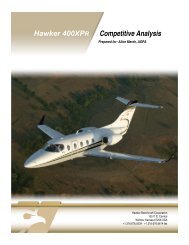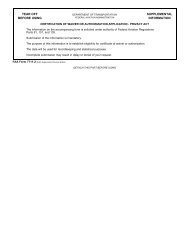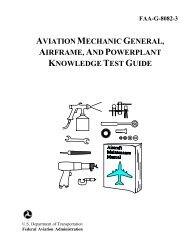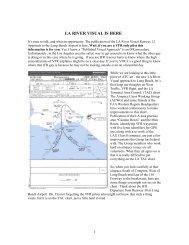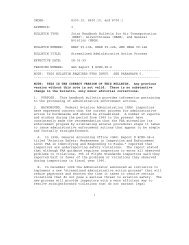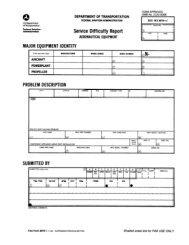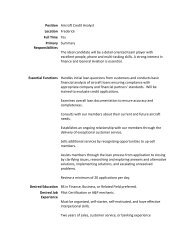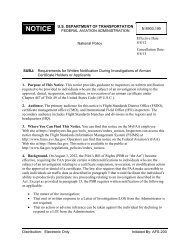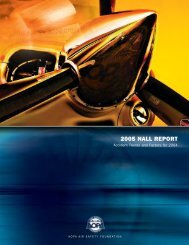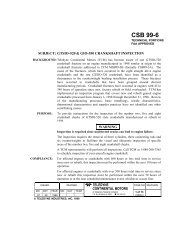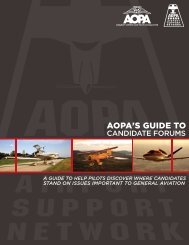2008 Nall Report - Aircraft Owners and Pilots Association
2008 Nall Report - Aircraft Owners and Pilots Association
2008 Nall Report - Aircraft Owners and Pilots Association
Create successful ePaper yourself
Turn your PDF publications into a flip-book with our unique Google optimized e-Paper software.
<strong>2008</strong> NALL REPORT<br />
Loss of<br />
directional control<br />
Stalls<br />
Short l<strong>and</strong>ings<br />
Hard l<strong>and</strong>ings<br />
Long l<strong>and</strong>ings<br />
Runway<br />
conditions<br />
Retractable gear<br />
operation<br />
Other<br />
L<strong>and</strong>ing<br />
423 total/8 fatal<br />
The l<strong>and</strong>ing phase extends from either the missed<br />
approach point (IMC) or the runway threshold<br />
(VMC) through touchdown, until the aircraft<br />
completes its ground run. It also includes aborted<br />
l<strong>and</strong>ings where touchdown has occurred <strong>and</strong> the<br />
l<strong>and</strong>ing is rejected.<br />
Typical l<strong>and</strong>ing accidents occur for one or more of<br />
the following reasons:<br />
• Loss of Directional Control – The inability of<br />
the pilot to keep the airplane on the runway, sometimes<br />
as a result of crosswinds, is a leading factor<br />
in l<strong>and</strong>ing accidents.<br />
• Inadequate Airspeed Control – <strong>Pilots</strong>’ inability<br />
to maintain the proper approach <strong>and</strong> l<strong>and</strong>ing airspeed<br />
can result in low altitude stalls, hard l<strong>and</strong>ings,<br />
touching down short of the runway, or l<strong>and</strong>ing<br />
farther down the runway than desired. Long<br />
l<strong>and</strong>ings often result in running off the far end <strong>and</strong><br />
colliding with ground objects.<br />
• Runway Conditions – Contaminated runways<br />
can decrease the effectiveness of aircraft brakes,<br />
leading to loss of control or departing the end of<br />
the runway.<br />
48 (11.3%)<br />
48 (11.3%)<br />
30 (7.1%)<br />
7 (1.7%)<br />
3 (0.7%)<br />
65 (15.4%)<br />
20 (4.7%)<br />
20 (4.7%)<br />
10 (2.4%)<br />
Types of L<strong>and</strong>ing Accidents<br />
27 (6.4%)<br />
66 (15.6%)<br />
57 (13.5%)<br />
Total<br />
Wind-related<br />
166 (39.2%)<br />
Airspeed-related<br />
0 50 100 150 200<br />
Figure 36<br />
• Retractable Gear Operation – Failure to extend,<br />
or improper operation of, the l<strong>and</strong>ing gear can<br />
lead to gear-up l<strong>and</strong>ings <strong>and</strong> inadvertent retraction<br />
during the l<strong>and</strong>ing <strong>and</strong> l<strong>and</strong>ing roll.<br />
As in previous years, l<strong>and</strong>ing accidents were the<br />
most common but least likely to be fatal. Loss of<br />
directional control was by far the most common<br />
reason for l<strong>and</strong>ing accidents (166 or 39.2 percent),<br />
with inadequate airspeed control (71) <strong>and</strong> hard<br />
l<strong>and</strong>ings (65) also responsible for significant numbers<br />
(Figure 36). At least 329 of the 423 l<strong>and</strong>ing<br />
accidents (78 percent) can be attributed to deficiencies<br />
in stick-<strong>and</strong>-rudder airmanship.<br />
Pilot Qualifications <strong>and</strong> Experience<br />
L<strong>and</strong>ings accounted for more than half of all accidents<br />
involving student pilots (66 of 115, or 57.4<br />
percent), <strong>and</strong> were the only major category in<br />
which the proportion of student pilots (15.6 percent)<br />
was higher than their proportion of all accident<br />
pilots (8.2 percent). ATPs were at reduced<br />
risk; they made up 25.9 percent of the pilot population<br />
but had only 6.6 percent of l<strong>and</strong>ing accidents<br />
with no fatalities. Five of the eight fatal l<strong>and</strong>ing<br />
accidents involved commercial pilots.<br />
Types of l<strong>and</strong>ing accidents varied with certificate<br />
level. Stalls were not involved in any of the ATP<br />
accidents but accounted for 5 percent of those suffered<br />
by commercial pilots, 10 percent of those<br />
involving private pilots, <strong>and</strong> 32 percent of those<br />
by student pilots. Hard l<strong>and</strong>ings made up about<br />
twice the proportion of all l<strong>and</strong>ing accidents among<br />
private <strong>and</strong> student pilots (18 <strong>and</strong> 20 percent, respectively)<br />
as among commercial <strong>and</strong> ATPs (about<br />
10 percent for each). On the other h<strong>and</strong>, loss of<br />
directional control accounted for 54 percent of ATP<br />
l<strong>and</strong>ing accidents, 44 percent among commercial<br />
pilots, 38 percent among private pilots, <strong>and</strong> 36 percent<br />
among student pilots. <strong>Pilots</strong> involved in l<strong>and</strong>ing<br />
accidents tended to have less time in type than<br />
other accident pilots (data not shown), though it’s<br />
worth noting that three-quarters of those at every<br />
certificate level, including student, had more than 25<br />
hours.<br />
<strong>Aircraft</strong> Class<br />
Eighty-two percent (348) of l<strong>and</strong>ing accidents were<br />
in fixed-gear singles, a disproportionate number of<br />
which (132, or 38 percent of all fixed-gear singles)<br />
were tailwheel models (Figure 37). Only three of<br />
eight fatal accidents took place in SEF aircraft,<br />
<strong>and</strong> none were in tail-draggers. Retractable singles<br />
24 25



